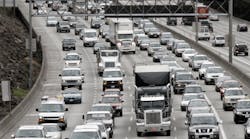In a proposed rule to be published Friday, the Federal Highway Administration (FHWA) takes steps toward a standardized reporting system intended to better gauge what's working well and where problems abound across the National Highway System. Part of that will include states measuring how much of interstate roadways trucks can travel on reliably.
When motorists head out on the road, "they allow sufficient time for travel . . . and expect to be there on time. Freight shippers have the same expectation when they estimate how much time it takes to deliver their products, often perishable goods," writes FHWA Administrator Gregory Nadeau in a blog post earlier this week.
One of the goals of this proposed rule is to set standards for states to measure highway congestion that will then be presented in a national data "bucket," so to speak — ultimately to help target and fix problem areas. This action by FHWA was spelled out in the Moving Ahead for Progress in the 21st Century Act, a.k.a. MAP-21, with some further provisions rolled into latest highway funding legislation.
Why is it necessary to set up uniform performance measurement for the National Highway System? Because right now the information is piecemeal, coming from states in the various ways they record and report highway performance — if they have such measures, that is.
"Prior to MAP-21, there were no explicit requirements for state DOTs to demonstrate how their transportation program supported national performance outcomes," FHWA states in a draft copy of the proposed rule. "State DOTs were not required to measure condition/ performance, to establish targets, to assess progress toward goals, or to report condition/ performance in a nationally consistent manner."
That situation makes it difficult for FHWA to get an accurate readout on the National Highway System's performance, and whether projects to improve it are getting any traction.
Freight movement will be part of the standardized measures for states. Specifically, FHWA proposes that states record (1) "percent of the Interstate system mileage providing for reliable truck travel time" and (2) "percent of the Interstate system mileage uncongested."
Adding that with other system performance measures, FHWA also envisions a centralized website/Web app(s) that would serve as a comparison tool.
The agency says the overall goals of this new standardized national performance reporting are to:
• Reduce congestion on the National Highway System;
• Make surface transportation more reliable;
• Improve freight movement;
• Strengthen rural area access to trade markets, supporting economic development; and
• Do all this while boosting environmental sustainability.
And in addition to freight movement (or standstill), there will be more to measure. FHWA is looking to develop measures for states to record and report:
• Serious injuries per vehicle mile traveled;
• Fatalities per vehicle mile traveled;
• Total number of serious injuries;
• Total number of fatalities;
• Pavement condition on the interstate system;
• Pavement condition on non-interstate portions of the National Highway System;
• Bridge conditions on the National Highway System;
• Traffic congestion;
• Vehicle emissions;
• Freight movement on interstate highways;
• Performance of interstate highways; and
• Performance of non-interstate portions of the National Highway System.
Slated to be published Friday, April 22 in the Federal Register, this proposed rule is just one in a series of related FHWA regulatory actions. In another back on March 15, the agency laid some groundwork changes to the Highway Safety Improvement Program — a key vehicle for federal assistance funding — that removed some old state reporting requirements and paved the way for these new ones.
FHWA is holding a webinar Thursday, April 21 to discuss "an overview of the complete proposal." Click here to register for the webinar.



